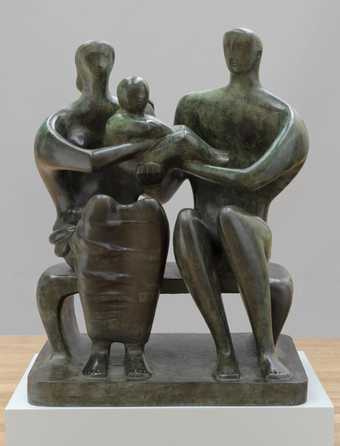
Henry Moore OM, CH, Family Group 1949, cast 1950–1. Tate. © The Henry Moore Foundation. All Rights Reserved.
Henry Moore
13 rooms in Modern and Contemporary British Art
From the comfort of family to the destruction of war, Moore’s sculptures and drawings explore enduring subjects
Henry Moore knew he wanted to become a sculptor from an early age. However, at 18, he enlisted to fight in the First World War. After the war, an ex-serviceman’s grant allowed him to enroll at art school in Leeds and he later studied at the Royal College of Art, London. Moore’s drawings and sculptures reveal a wide range of influences and provide insight into his experiences and interests. But for Moore, art was more than a means of expression, he believed it should serve society. He stated that ‘sculpture, even more than painting... is a public art’. This conviction informed both the scale and subject matter of his work.
His experience of two world wars and the threat of nuclear warfare had a profound impact on Moore. Many of his works explore the frailty of the human body in the context of such conflict. He also produced work that reflected his commitment to activism. In 1958, Moore became a founding member of the Campaign for Nuclear Disarmament (CND).
Family was an enduring subject for Moore, something he returned to throughout his career. This ongoing interest suggests the strength and comfort of family can endure the atrocity of war. Moore saw some of his work as a reflection of his own happy family life, but he also understood the power of the viewer. He said: ‘Part of the excitement of sculpture is the associations it can arouse, quite independent of the original aims and ideas of the sculptor.’
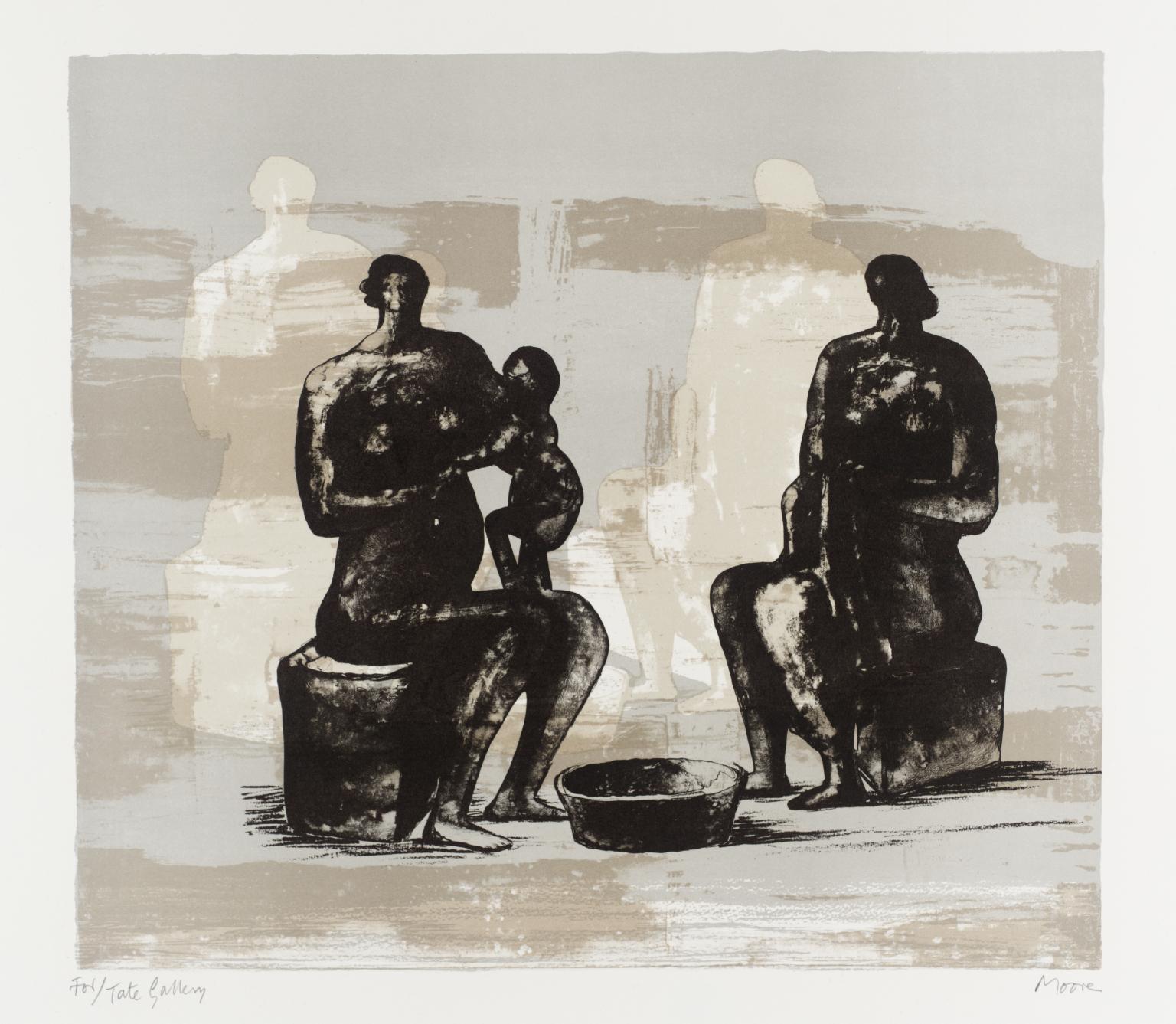
Henry Moore OM, CH, Two Women Bathing Child I 1973
1/23
artworks in Henry Moore
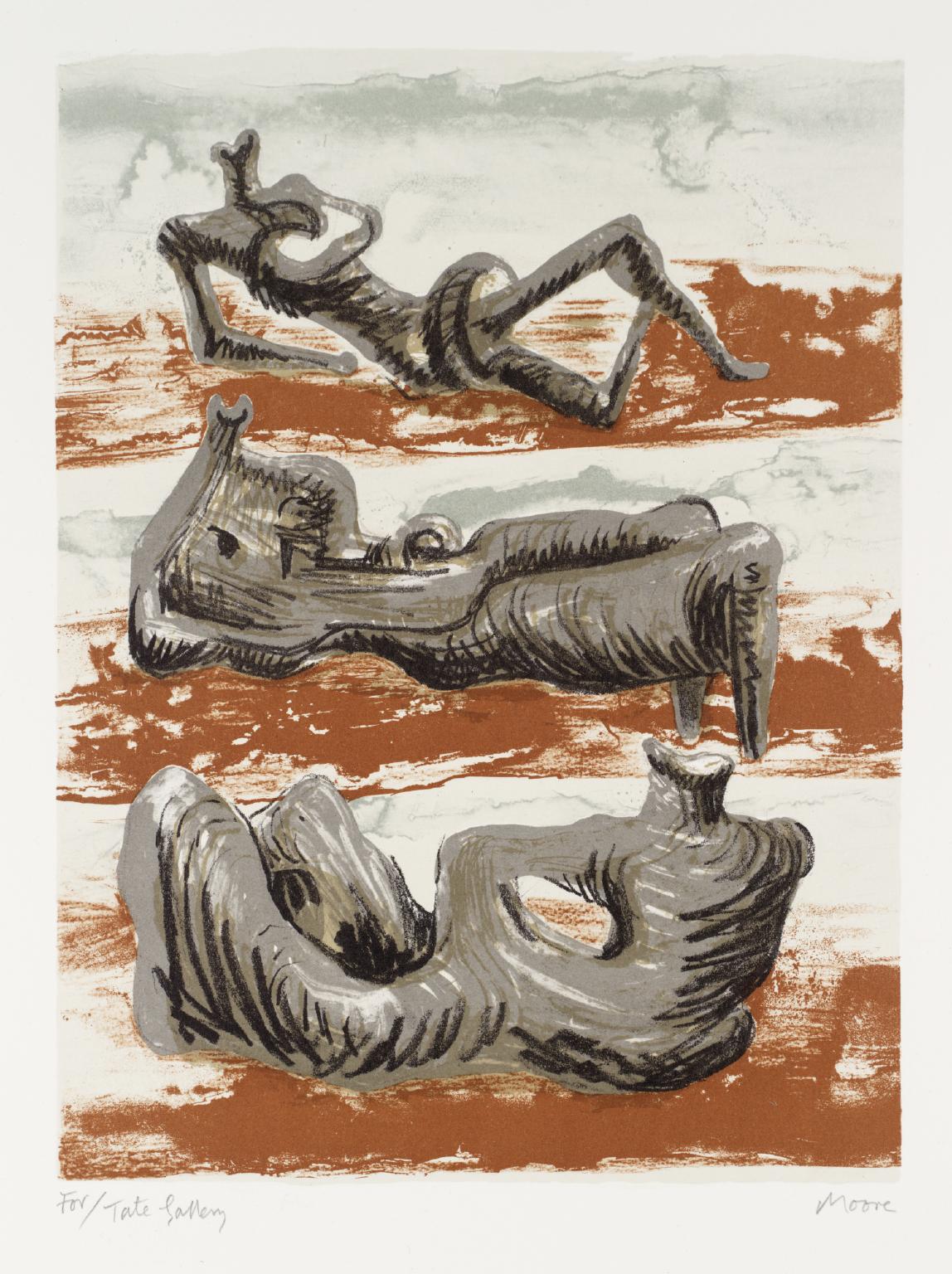
Henry Moore OM, CH, Three Reclining Figures 1975
2/23
artworks in Henry Moore
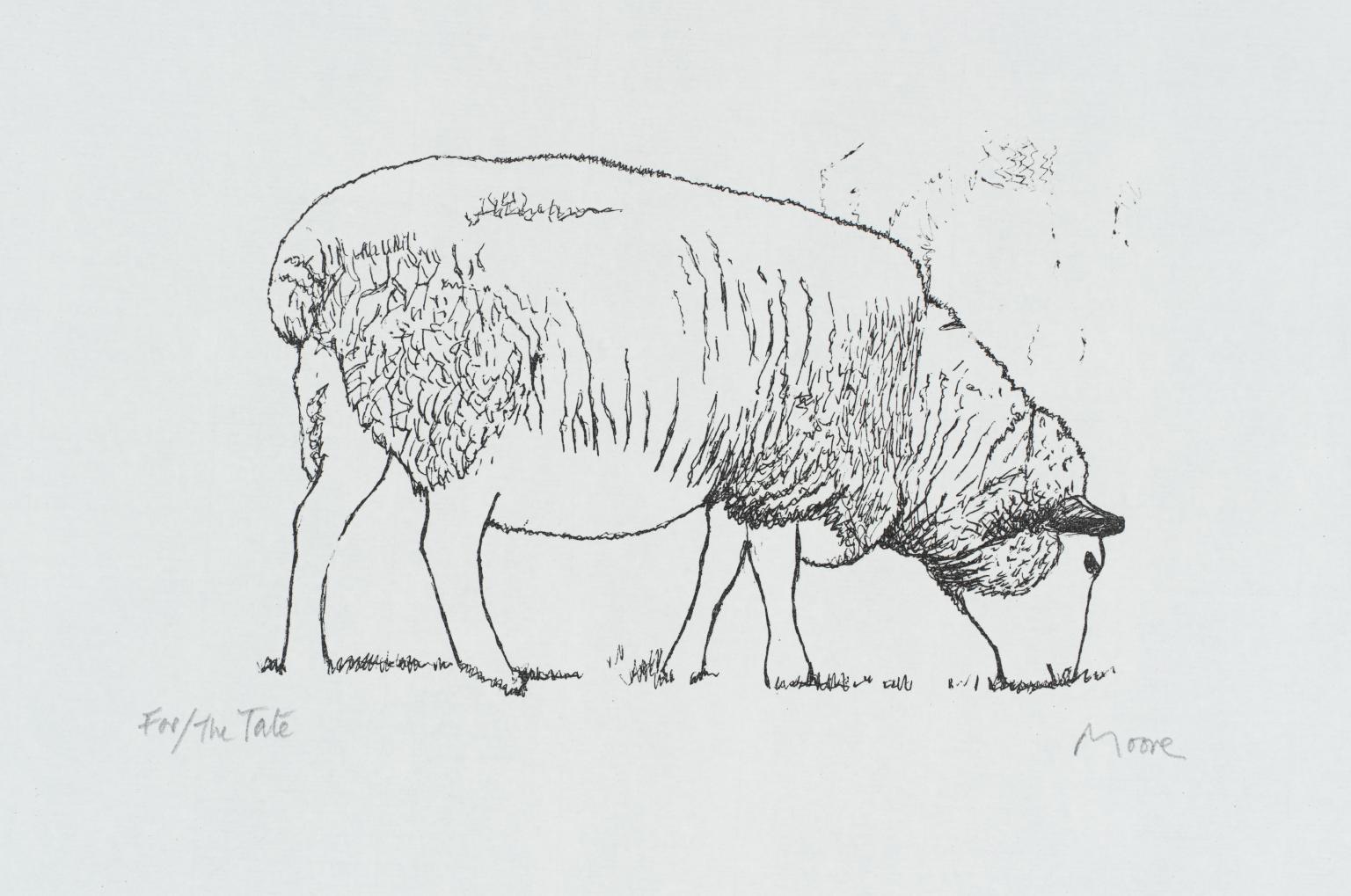
Henry Moore OM, CH, Sheep Grazing 1974
3/23
artworks in Henry Moore

Henry Moore OM, CH, Stone II 1977
4/23
artworks in Henry Moore
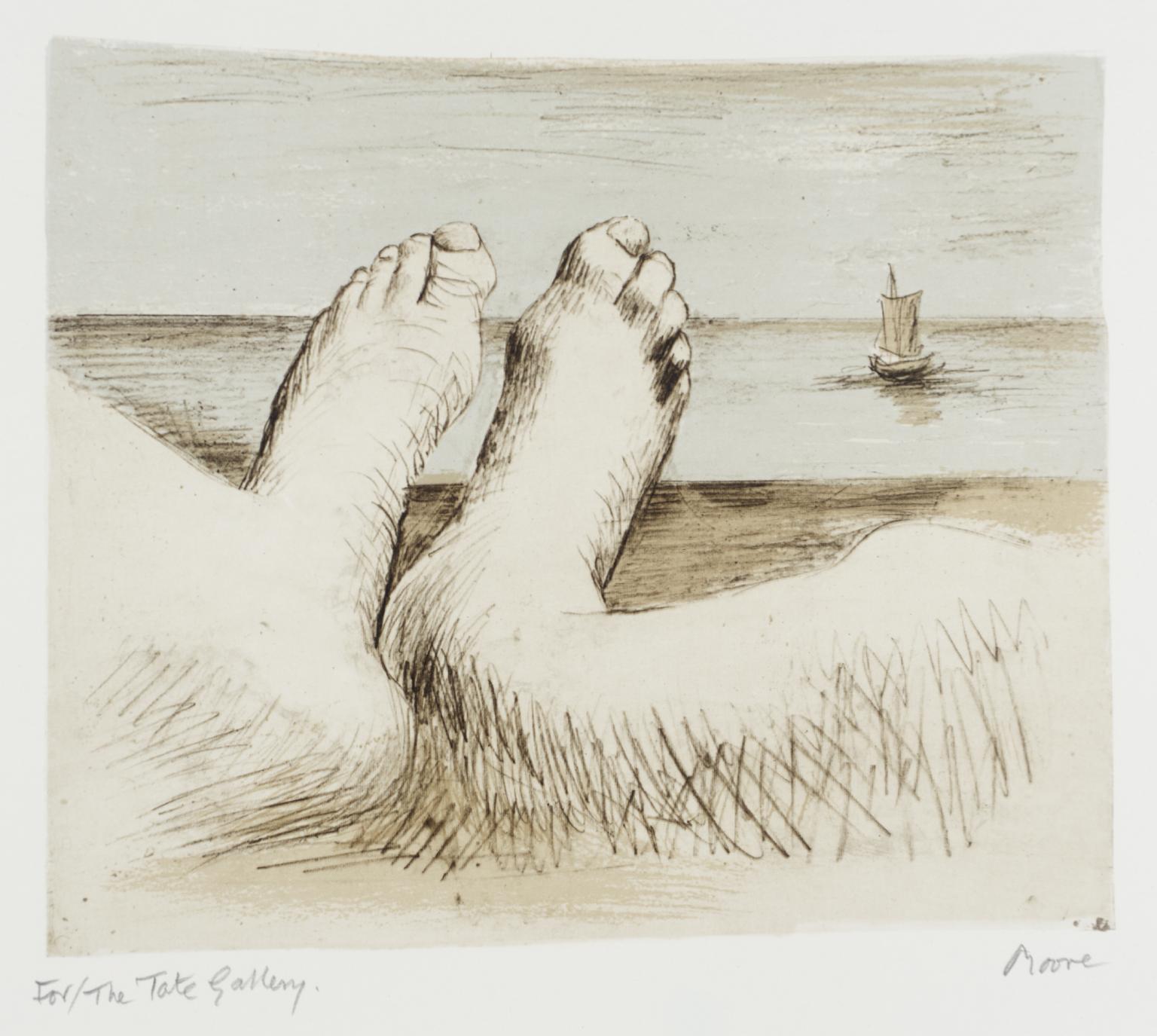
Henry Moore OM, CH, Feet on Holiday II 1979
5/23
artworks in Henry Moore
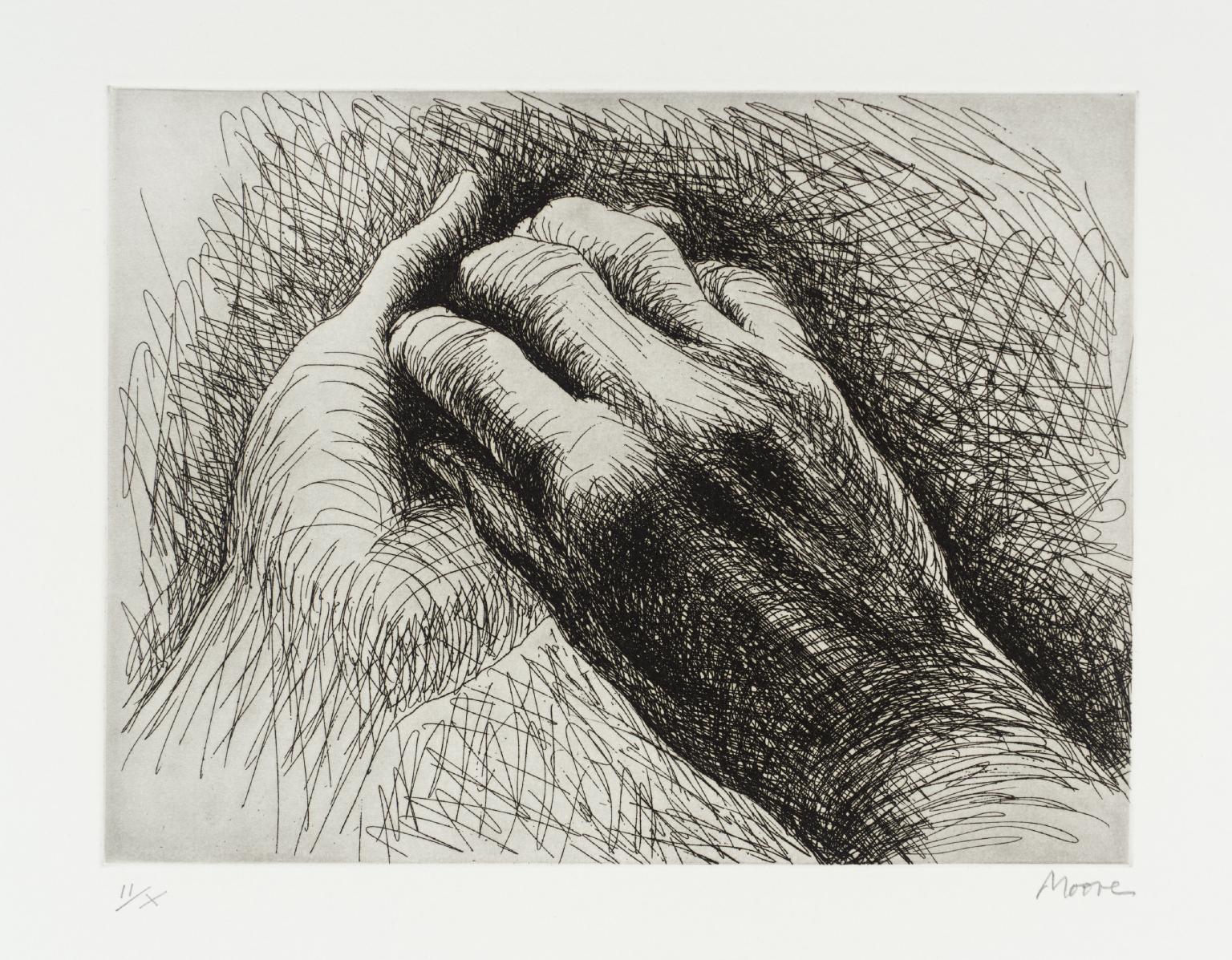
Henry Moore OM, CH, The Artist’s Hand II 1979
Henry Moore's subject is the aged body. He made these drawings of his own hands when he was eighty-one and suffering from ill-health. 'Hands can convey so much' he said, 'they can beg or refuse, take or give, be open or clenched, show content or anxiety. They can be young or old, beautiful or deformed'.
Moore saw these prints as belonging to a long tradition of fascination with hands as vehicles of expression: 'Throughout the history of sculpture and painting one can find that artists have shown through the hands the feelings they wished to represent.'
Gallery label, September 2004
6/23
artworks in Henry Moore
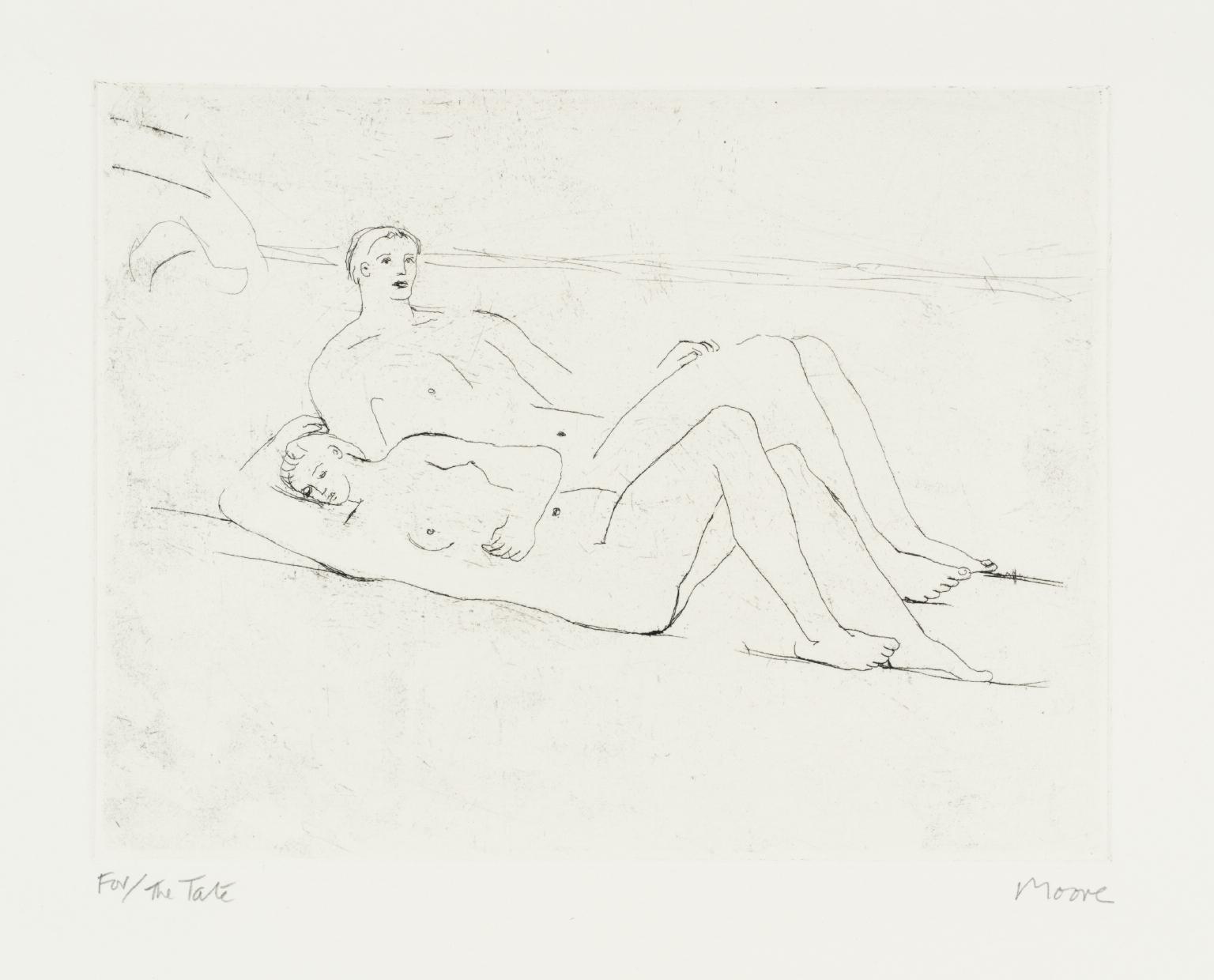
Henry Moore OM, CH, Reclining Figures on Beach 1975–6
7/23
artworks in Henry Moore
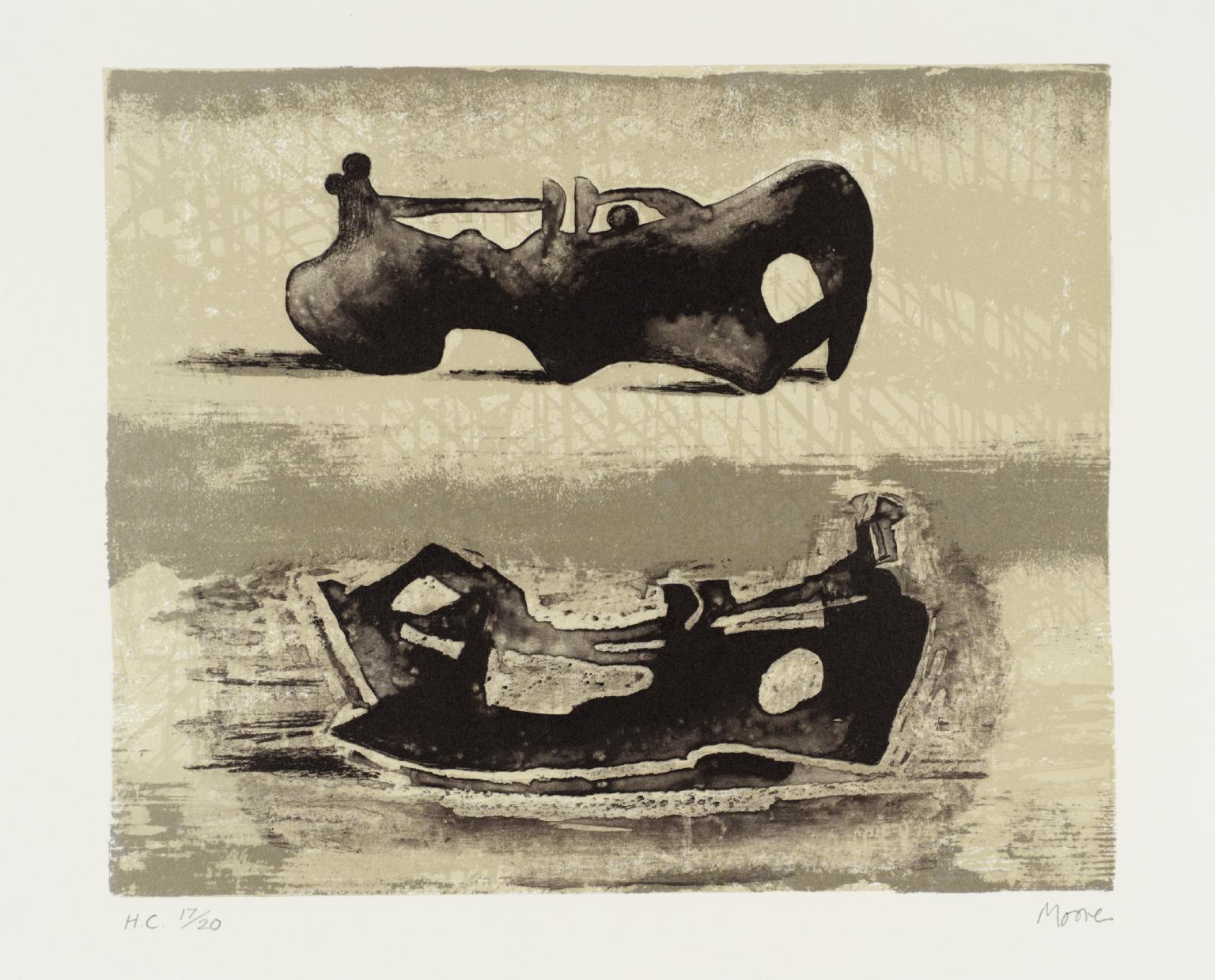
Henry Moore OM, CH, Two Reclining Figures 1976
8/23
artworks in Henry Moore
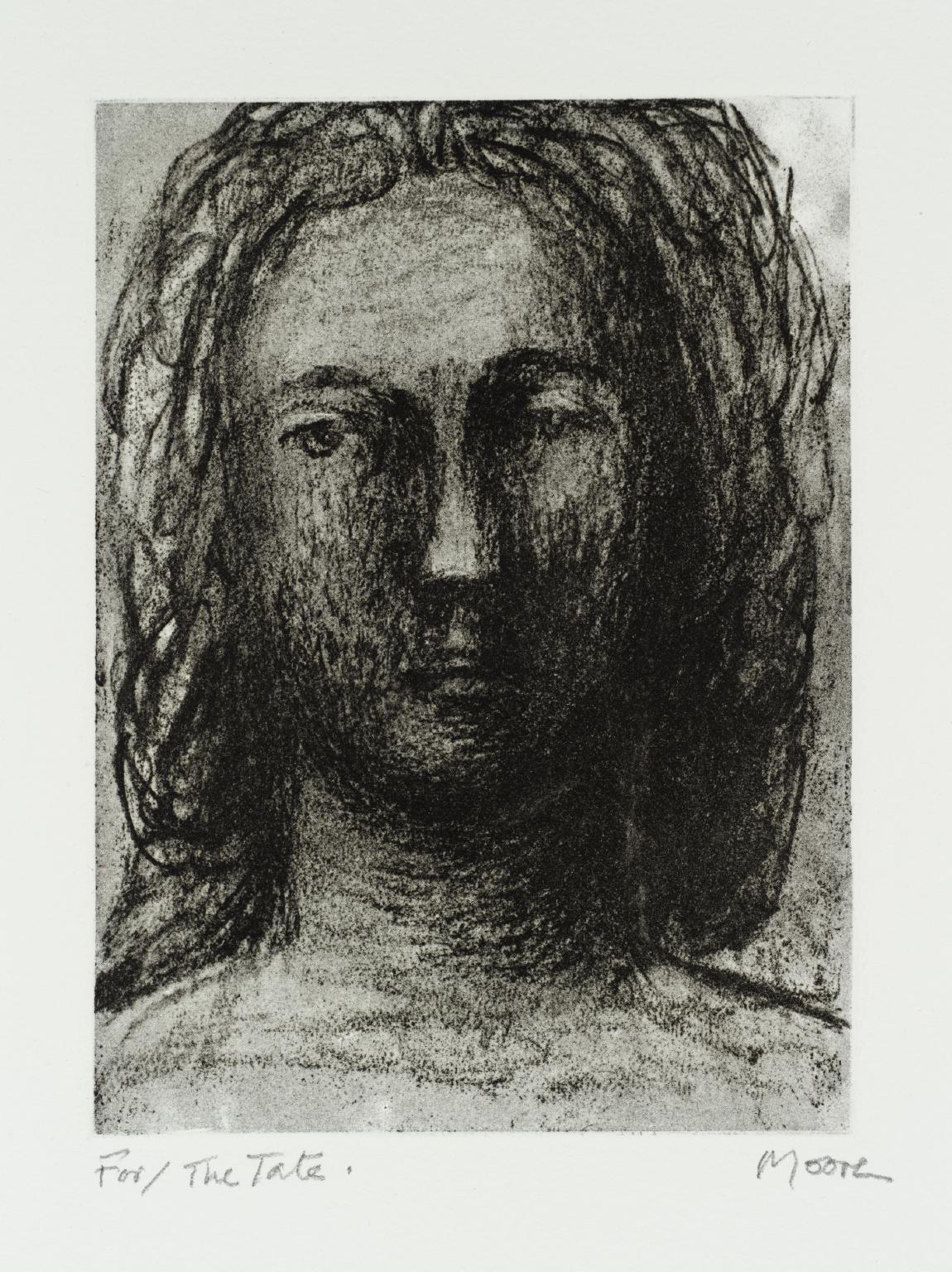
Henry Moore OM, CH, Head of Girl III 1981
9/23
artworks in Henry Moore
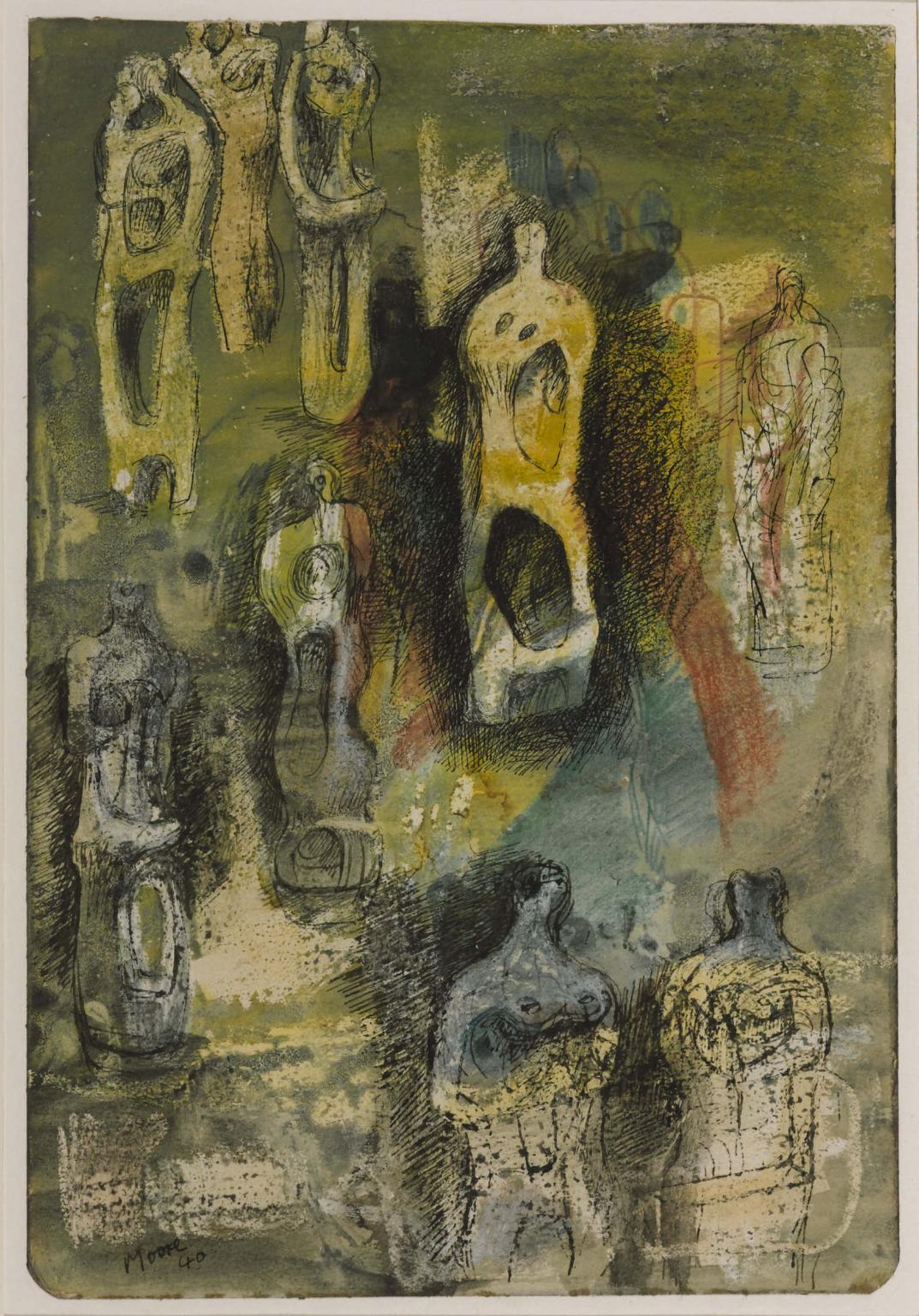
Henry Moore OM, CH, Standing Figures 1940
Henry Moore used drawing as an investigative process where he could think through new works. These half-finished sketches represent his ideas for future carvings in wood. They evoke fragmented bones or human forms whose ghostly appearance reflects his mood during the Second World War. The conditions of war prevented Moore from producing any sculptures until the Madonna and Child projects of 1943, also on display in this gallery.
Gallery label, January 2025
10/23
artworks in Henry Moore
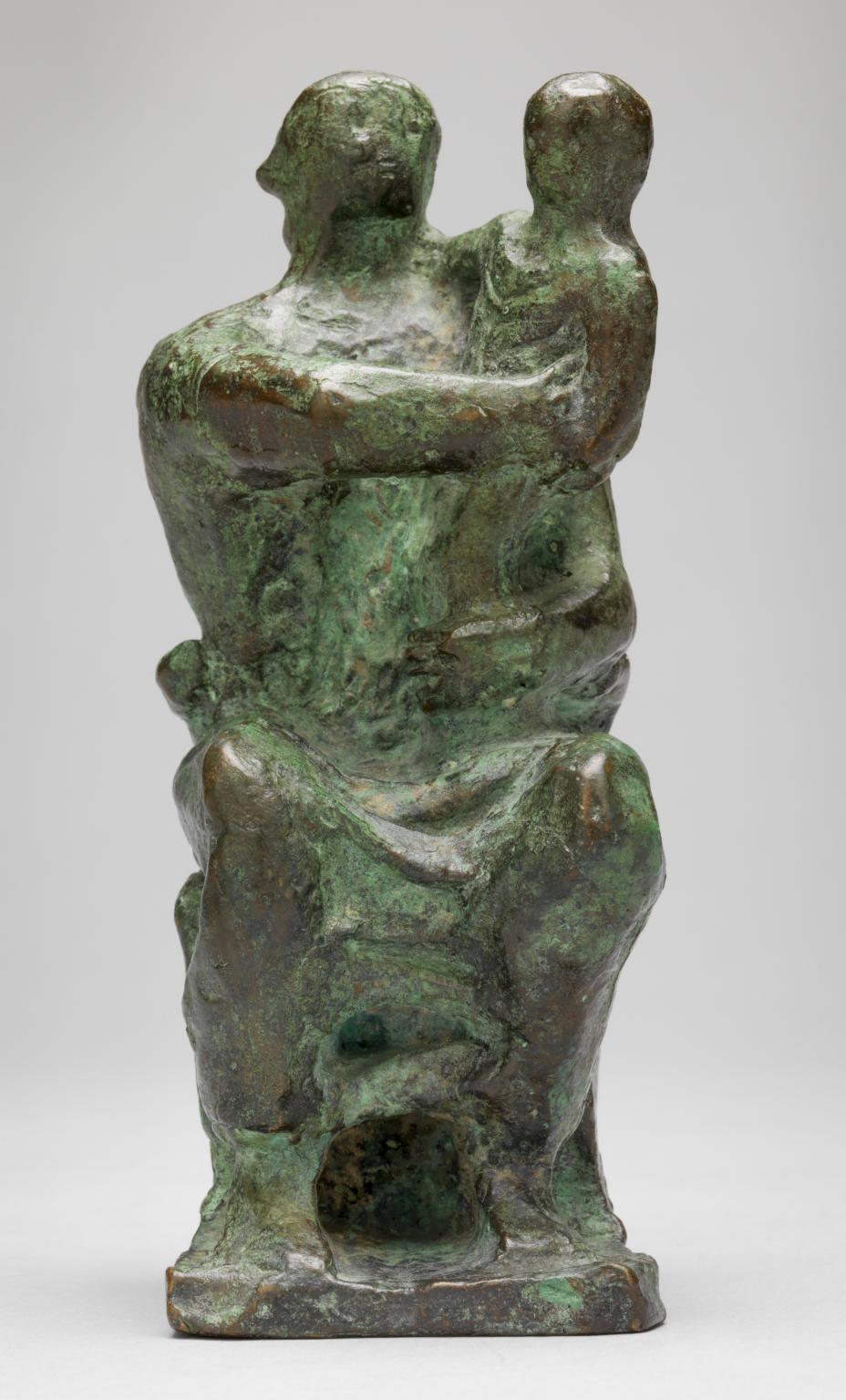
Henry Moore OM, CH, Maquette for Madonna and Child 1943, cast 1944–5
The mother and child had been a major theme in Moore’s work since the 1920s. Yet when the vicar of St Matthew, Northampton, invited Moore to make a sculpture of the Madonna and Child, he was reluctant to accept. He felt unsure how to adapt his secular interests to the Christian tradition. These bronzes are casts of the original terracotta models he made for the project. They are unusually naturalistic and steeped in references to Renaissance religious art. This suggests Moore was trying to produce a sculpture that people would find both modern and familiar.
Gallery label, September 2016
11/23
artworks in Henry Moore

Henry Moore OM, CH, Family Group 1949, cast 1950–1
Family Group is derived from one of a number of maquettes that Moore made for a sculpture for Impington Village College in Cambridgeshire. In the end none of them was accepted. Several years later, however, he was approached to make a sculpture for the Barclay Secondary School in Stevenage and returned to the theme. The bronze was cast in an edition of four. One is still at the Barclay Secondary School. The others were acquired by the Museum of Modern Art in New York, Nelson D Rockefeller, and Tate.
Gallery label, September 2004
12/23
artworks in Henry Moore
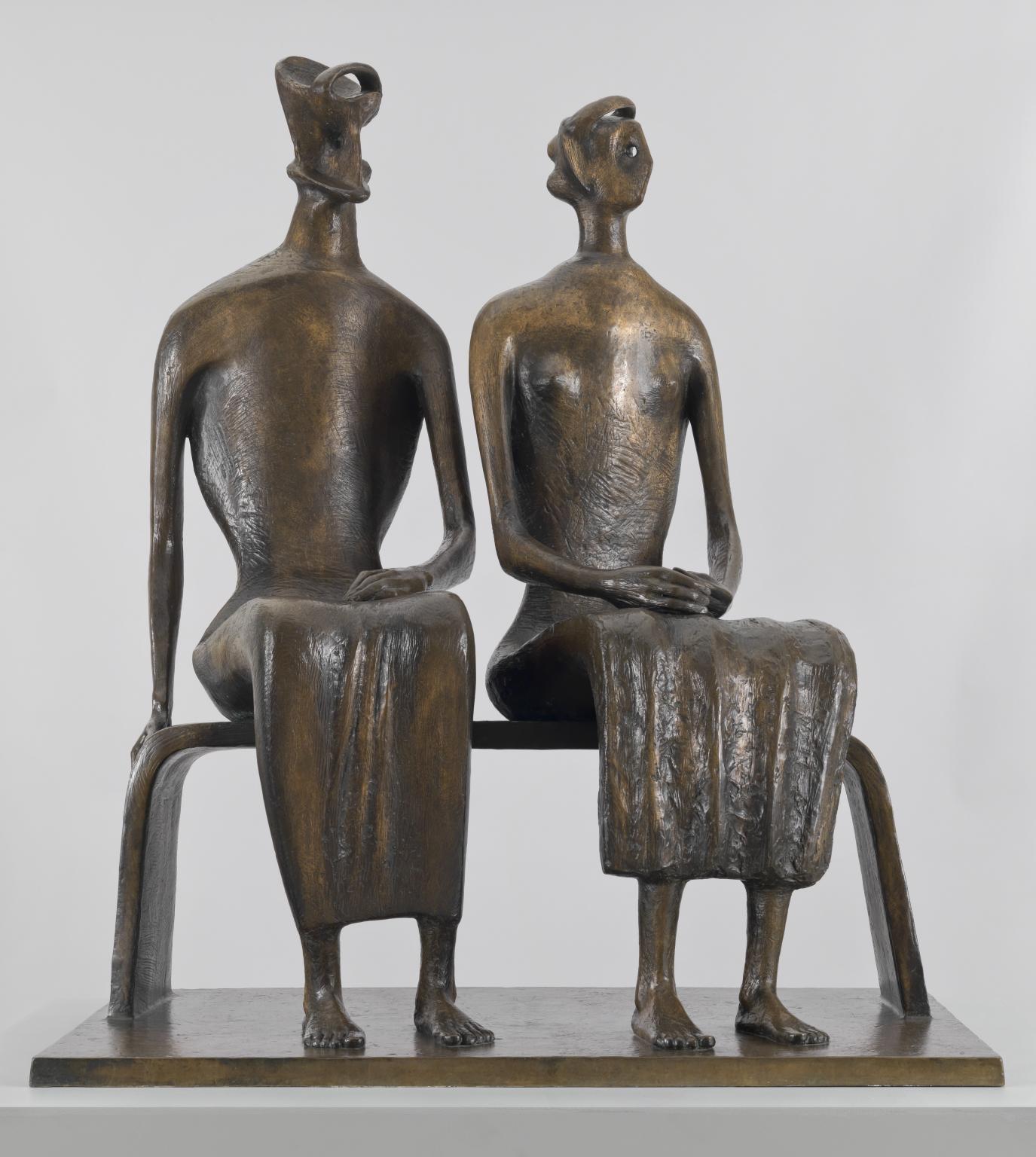
Henry Moore OM, CH, King and Queen 1952–3, cast 1957
According to Henry Moore, this sculpture was inspired by ancient representations of monarchs. He said it was ‘connected with the archaic... idea of a king... the head of the king which is a head and a crown, face and beard combined into one form.’ Although Moore emphasised anonymous and universal themes of rulership, he created King and Queen around the same time as the coronation of Queen Elizabeth II. Images of the ceremony were widely published in the media.
Gallery label, February 2025
13/23
artworks in Henry Moore
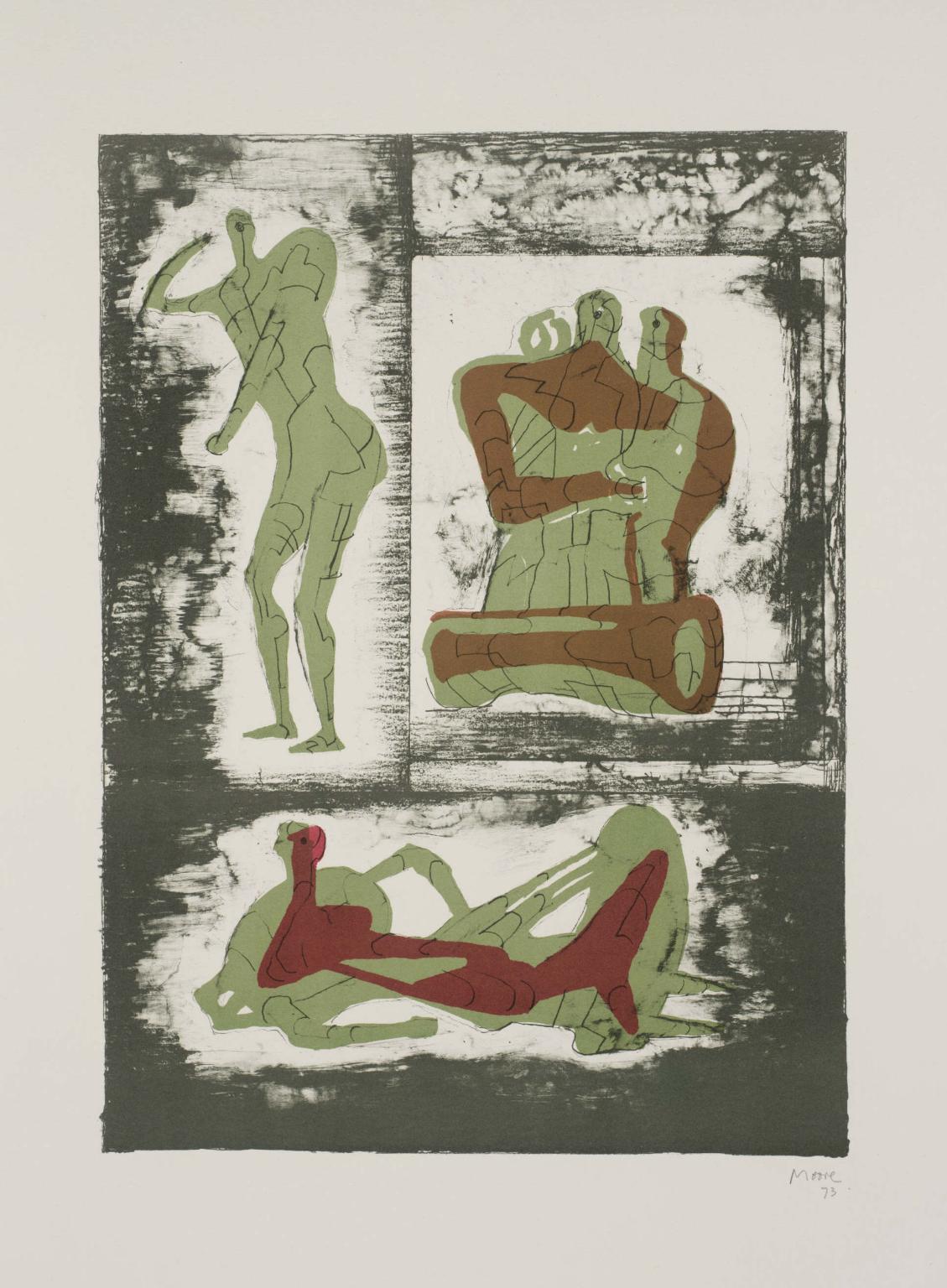
Henry Moore OM, CH, Reclining & Standing Figure and Family Group 1973
14/23
artworks in Henry Moore

Henry Moore OM, CH, Mother and Child 1953, cast c.1954
Many of Henry Moore’s sculptures show a nurturing mother-child relationship. Mother and Child depicts a darker and more disturbing dynamic. Moore wanted to explore the more complex side of rearing a child. Sometimes, he said, ‘it’s as though they want to devour their parent... as though the parent, the mother, had to hold the child at arm’s length.’ The jagged style enhances the menacing feeling of the figures and their relationship to one another.
Gallery label, February 2025
15/23
artworks in Henry Moore
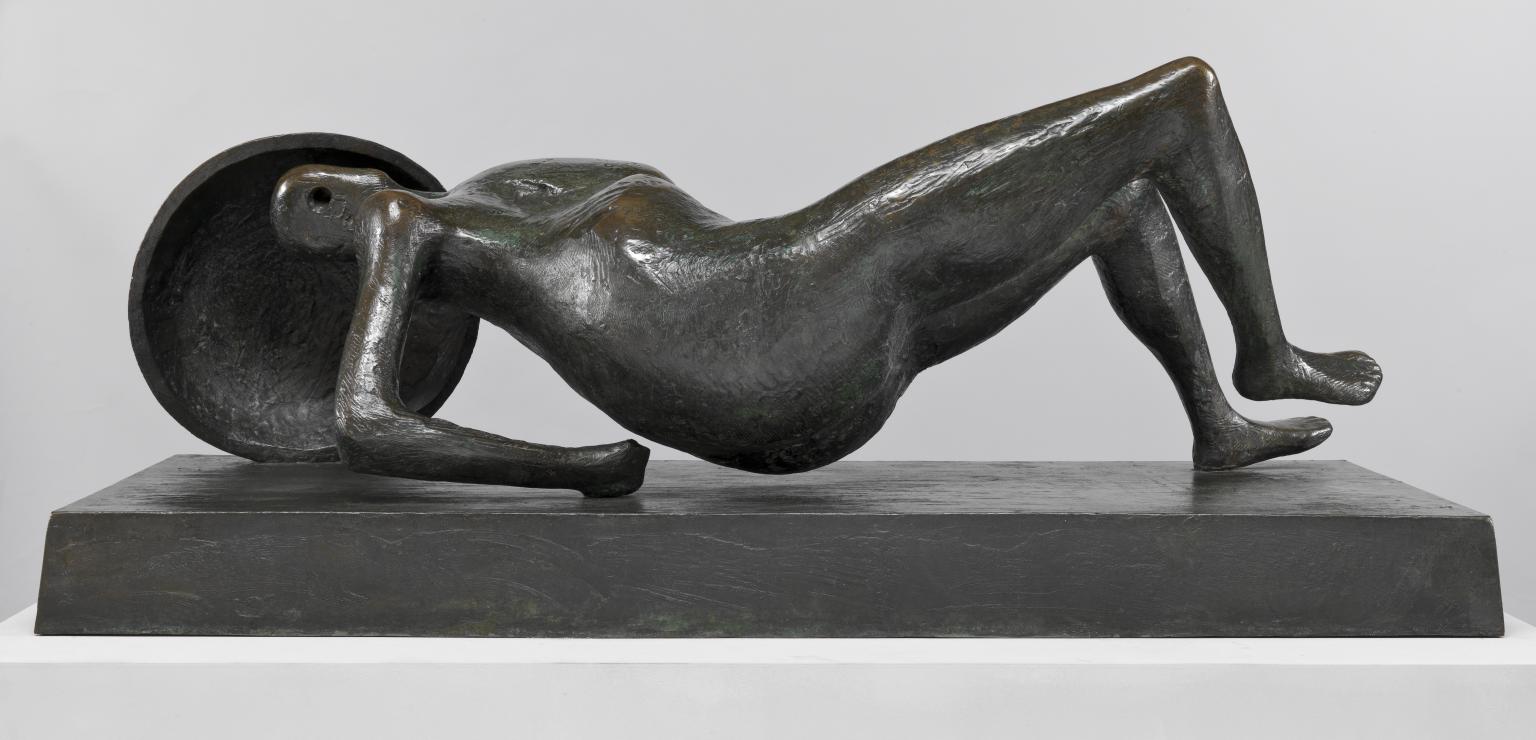
Henry Moore OM, CH, Falling Warrior 1956–7, cast c.1957–60
The sense of movement in this pose was very important for Henry Moore. He said, ‘I wanted a figure that was still alive... [I made] the action that of a figure in the act of falling, and the shield became a support for the warrior, emphasising the dramatic moment that precedes death.’ Moore only ever created six sculptures of large male figures. Falling Warrior is one of them, one of only three to show the male figure alone.
Gallery label, February 2025
16/23
artworks in Henry Moore
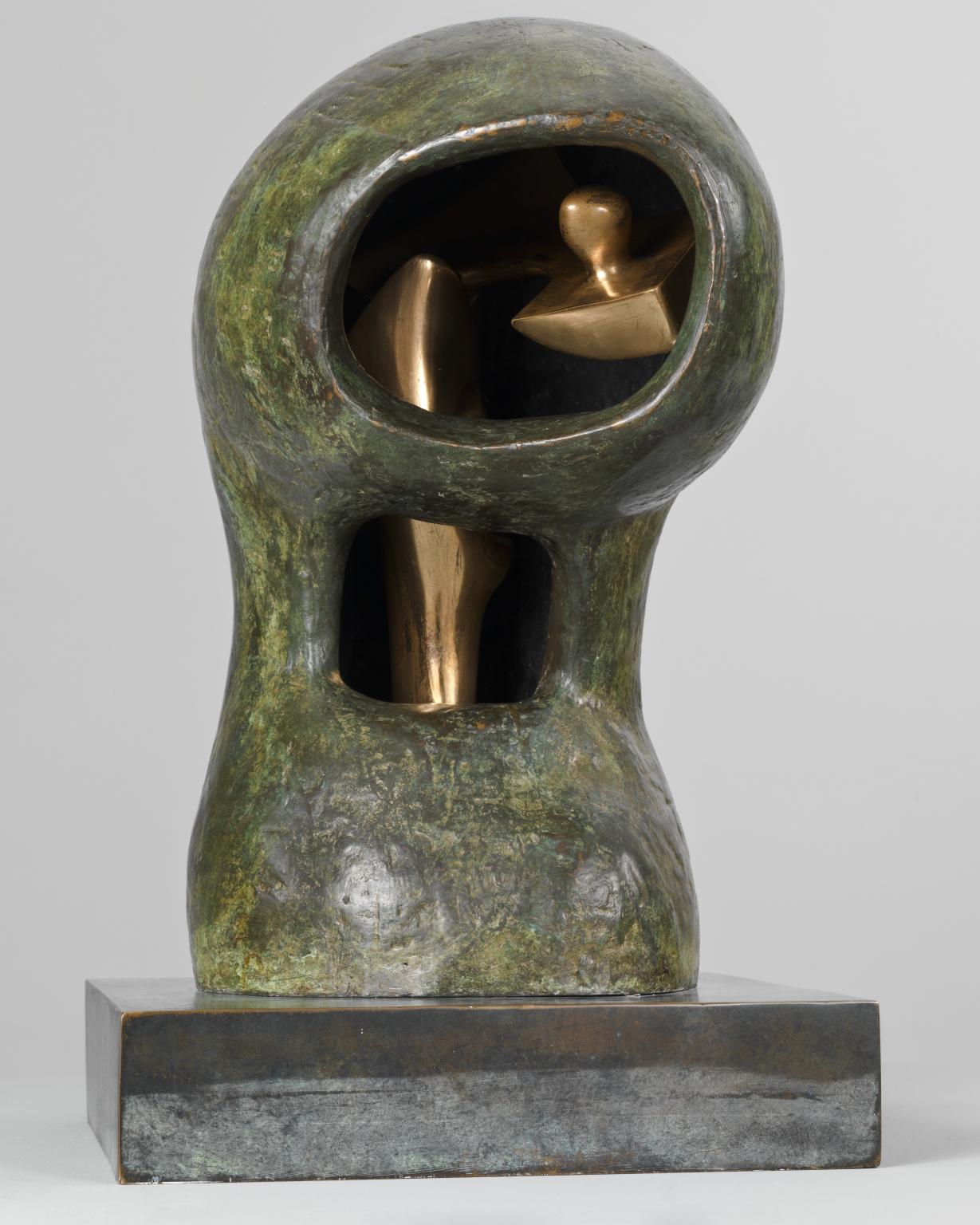
Henry Moore OM, CH, Helmet Head No.4: Interior-Exterior 1963, cast date unknown
This work is part of a series Henry Moore created in which a hard outer ‘helmet’ shell encloses a smaller, contrasting ‘head’ form within. According to Moore, ‘the idea of one form inside another form may owe some of its incipient beginnings to my interest at one stage when I discovered armour. I spent many hours in the Wallace Collection, in London, looking at armour.’ In the context of Moore’s other work, this series can also be seen as an abstract development of the theme of mother and child.
Gallery label, February 2025
17/23
artworks in Henry Moore

Henry Moore OM, CH, Maquette for Madonna and Child 1943, cast 1944–5
The mother and child had been a major theme in Moore’s work since the 1920s. Yet when the vicar of St Matthew, Northampton, invited Moore to make a sculpture of the Madonna and Child, he was reluctant to accept. He felt unsure how to adapt his secular interests to the Christian tradition. These bronzes are casts of the original terracotta models he made for the project. They are unusually naturalistic and steeped in references to Renaissance religious art. This suggests Moore was trying to produce a sculpture that people would find both modern and familiar.
Gallery label, September 2016
18/23
artworks in Henry Moore
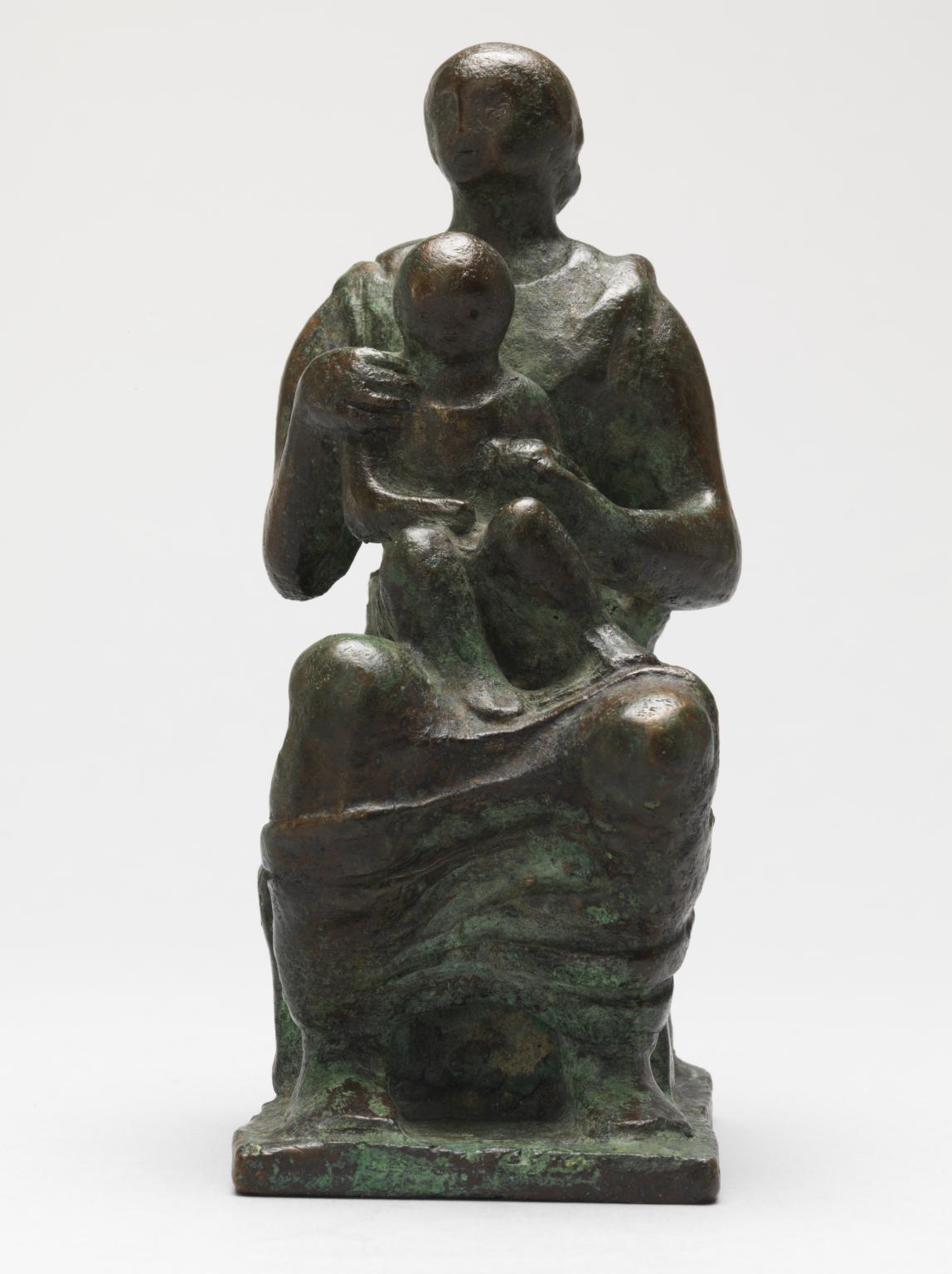
Henry Moore OM, CH, Maquette for Madonna and Child 1943, cast 1944–5
The mother and child had been a major theme in Moore’s work since the 1920s. Yet when the vicar of St Matthew, Northampton, invited Moore to make a sculpture of the Madonna and Child, he was reluctant to accept. He felt unsure how to adapt his secular interests to the Christian tradition. These bronzes are casts of the original terracotta models he made for the project. They are unusually naturalistic and steeped in references to Renaissance religious art. This suggests Moore was trying to produce a sculpture that people would find both modern and familiar.
Gallery label, September 2016
19/23
artworks in Henry Moore
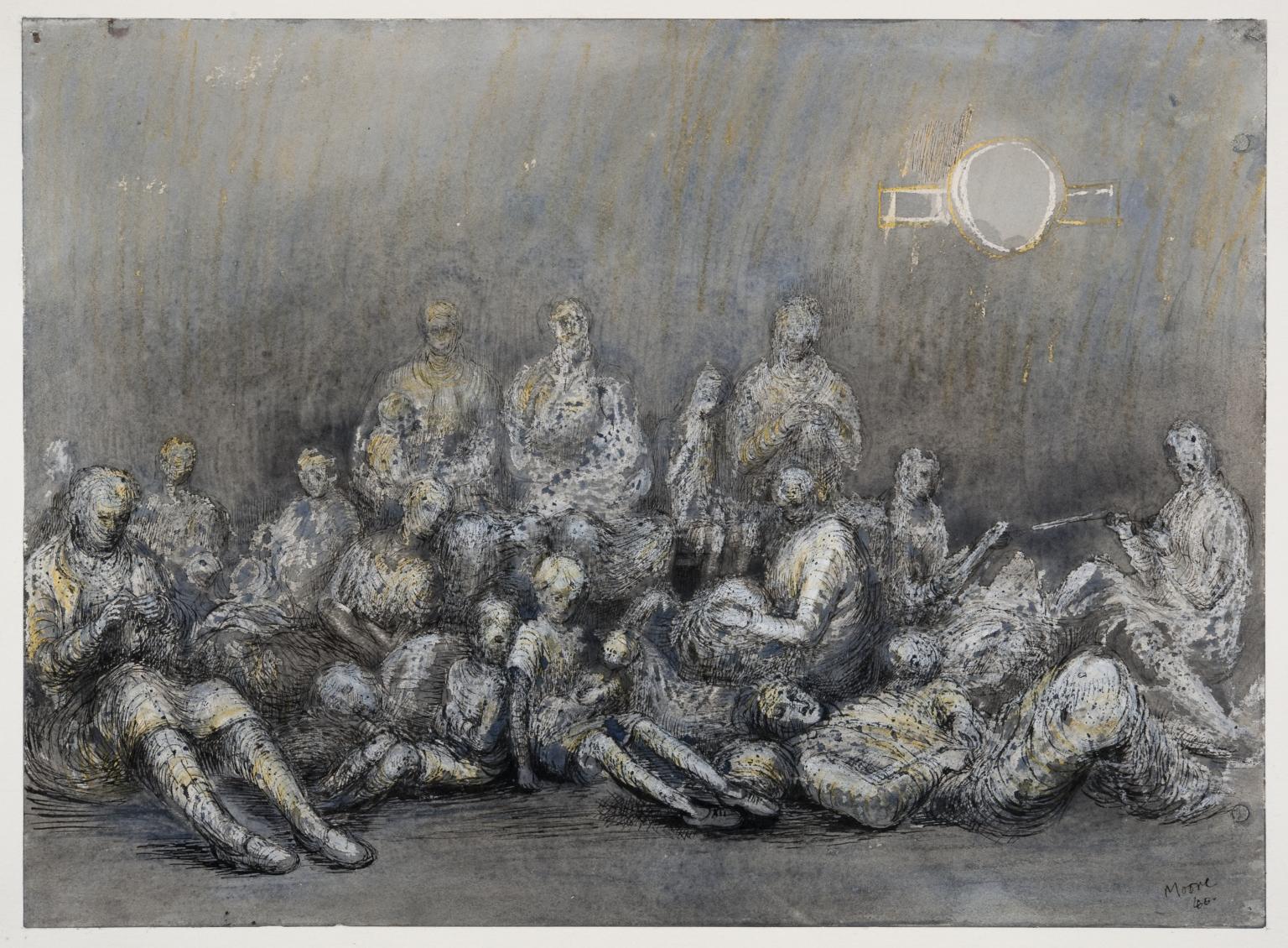
Henry Moore OM, CH, Grey Tube Shelter 1940
In autumn 1940, Moore took cover from an air raid in Belsize Park underground station. He was 'fascinated by the sight of people camping out deep under ground'. On returning to his studio, he made some drawings from memory. When Kenneth Clark, Director of the National Gallery and Chairman of the War Artists Advisory Committee, saw the pictures, he commissioned further drawings and appointed Moore as an official war artist. These drawings were exhibited in 1941 in the empty halls of the National Gallery whose artworks had been temporarily removed because of the war.
Gallery label, January 2025
20/23
artworks in Henry Moore
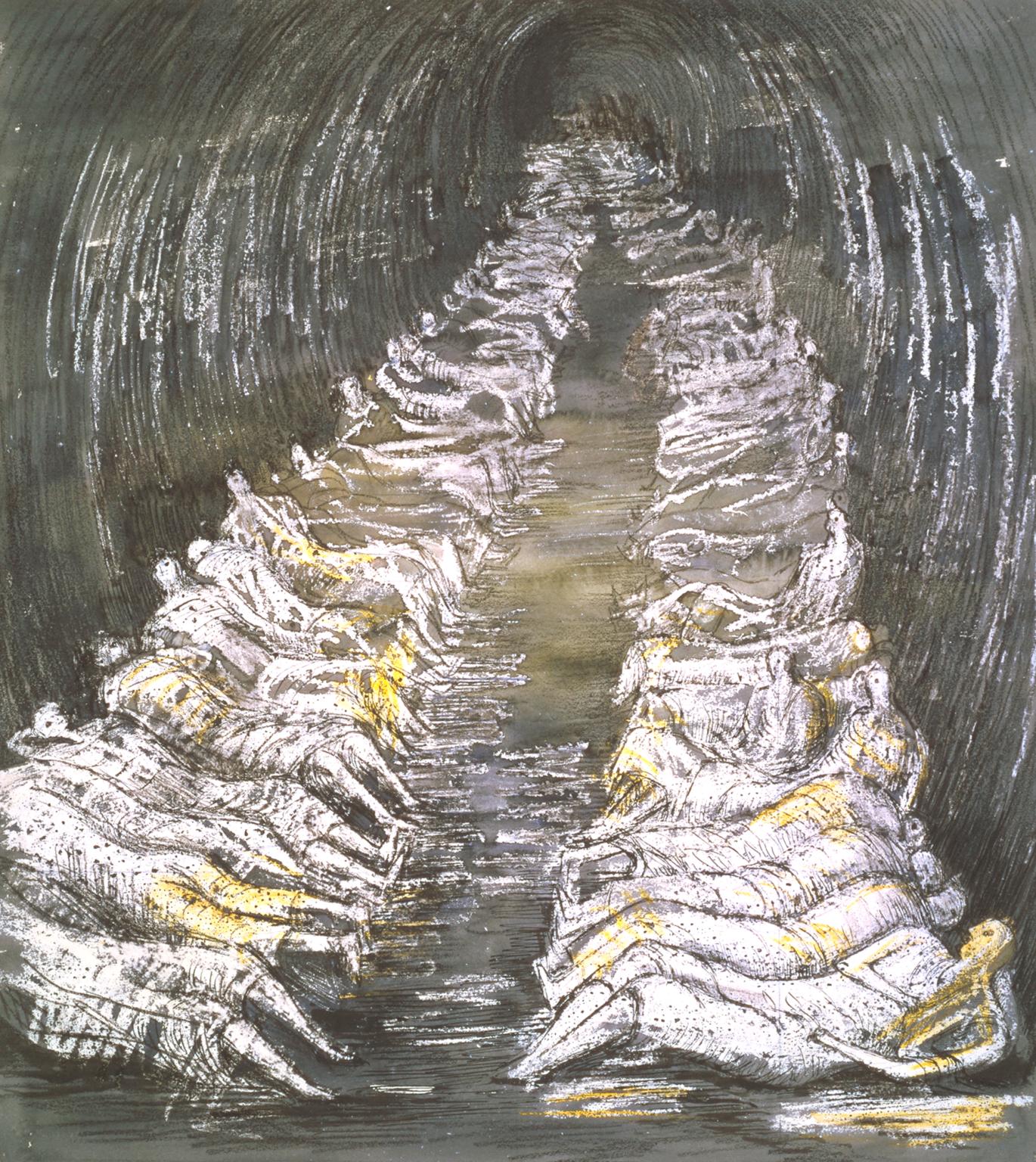
Henry Moore OM, CH, Tube Shelter Perspective 1941
This drawing of people sheltering in an underground station during the Second World War was exhibited at the National Gallery in 1941. The exhibition catalogue described it as 'a terrifying vista of recumbent shapes, pale as all underground life tends to be pale; regimented, as only fear can regiment; helpless yet tense, safe yet listening, uncouth, uprooted, waiting in the tunnel for the dawn to release them. This is not the descriptive journalism of art. It is imaginative poetry of a high order.'
Gallery label, January 2025
21/23
artworks in Henry Moore
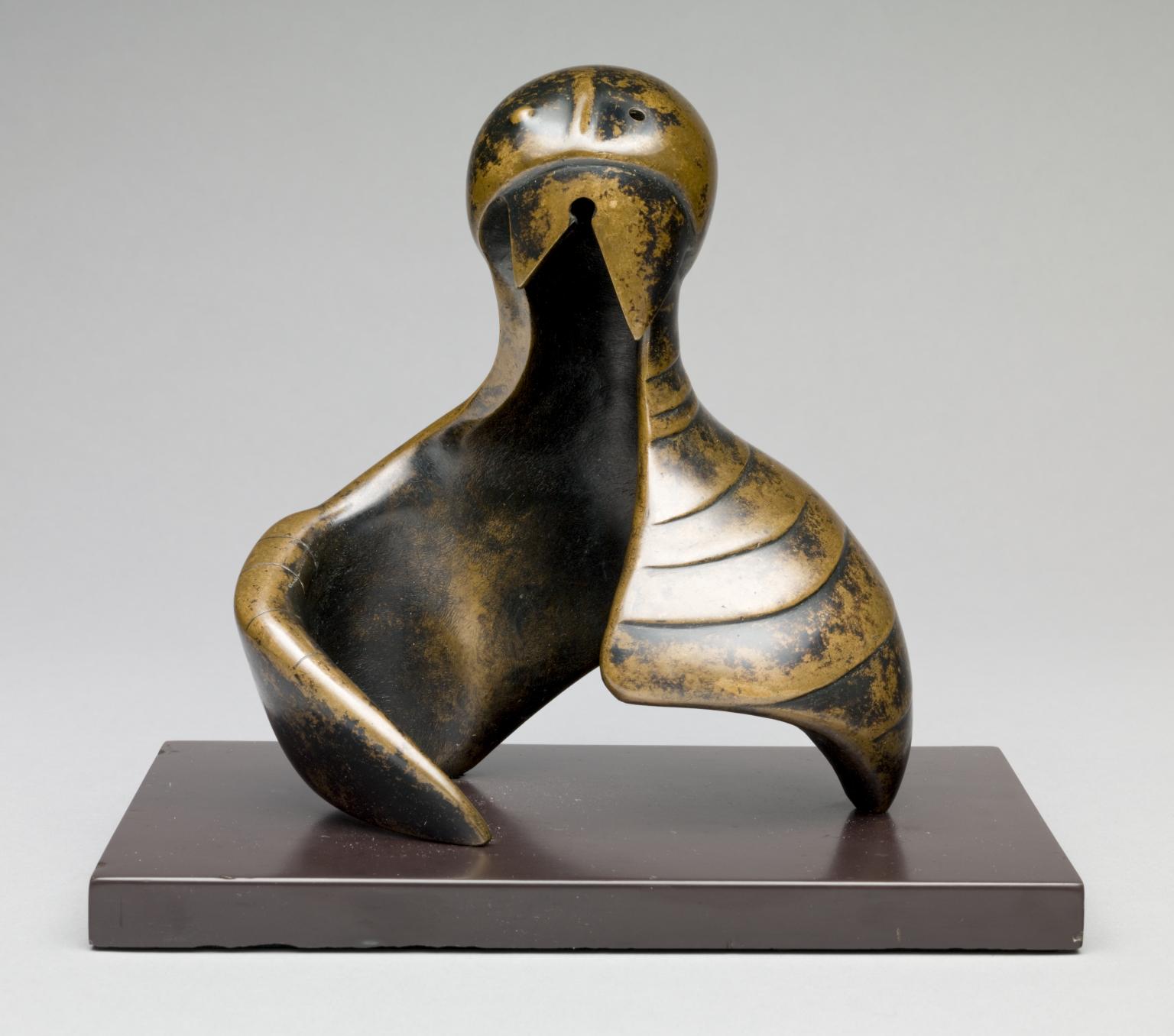
Henry Moore OM, CH, Helmet Head and Shoulders 1952, cast date unknown
Henry Moore first explored the theme of helmets and the bodies they protect in the late 1930s, in the run-up to the Second World War. He returned to it in the 1950s, in the war’s aftermath. Where his pre-war helmets contain a complex series of forms, his post-war helmets, such as this one, are hollowed out. The helmet’s asymmetrical curves highlight the void inside and its uneven lines give it the feeling of recovered battlefield debris.
Gallery label, February 2025
22/23
artworks in Henry Moore
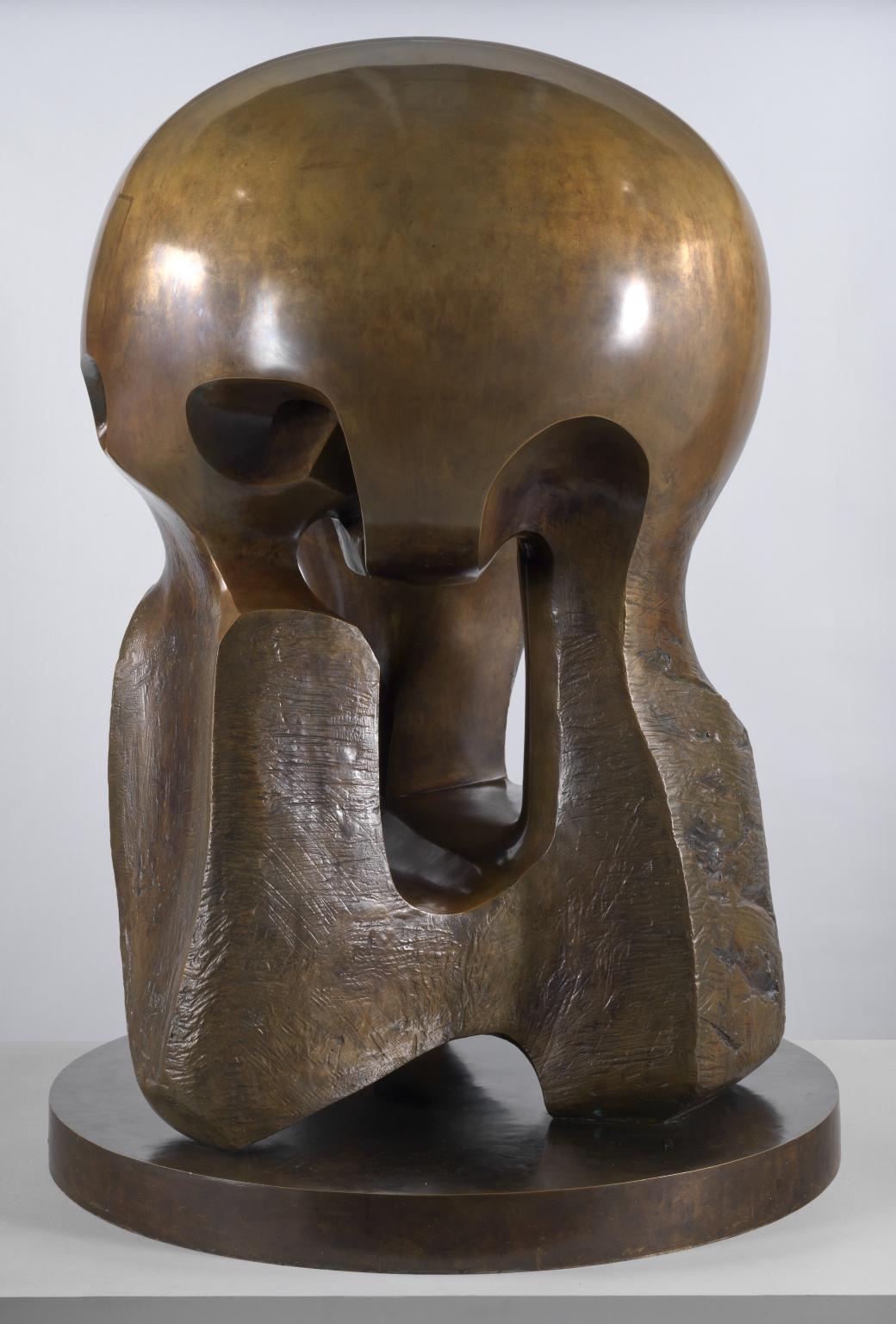
Henry Moore OM, CH, Atom Piece (Working Model for Nuclear Energy) 1964–5, cast 1965
In 1963 Moore was invited by the University of Chicago to make a sculpture commemorating the first controlled nuclear reaction, conducted at the university in 1942. This work is a model for the larger Nuclear Energy, unveiled in 1967. Moore intended it to convey ‘a contained power and force’ appropriate to the subject. The upper shape suggests a human skull or a mushroom cloud. The city of Hiroshima, which had been destroyed by a nuclear bomb in 1945, purchased one of the seven versions of this model in 1987.
Gallery label, February 2025
23/23
artworks in Henry Moore
Art in this room























You've viewed 6/23 artworks
You've viewed 23/23 artworks
